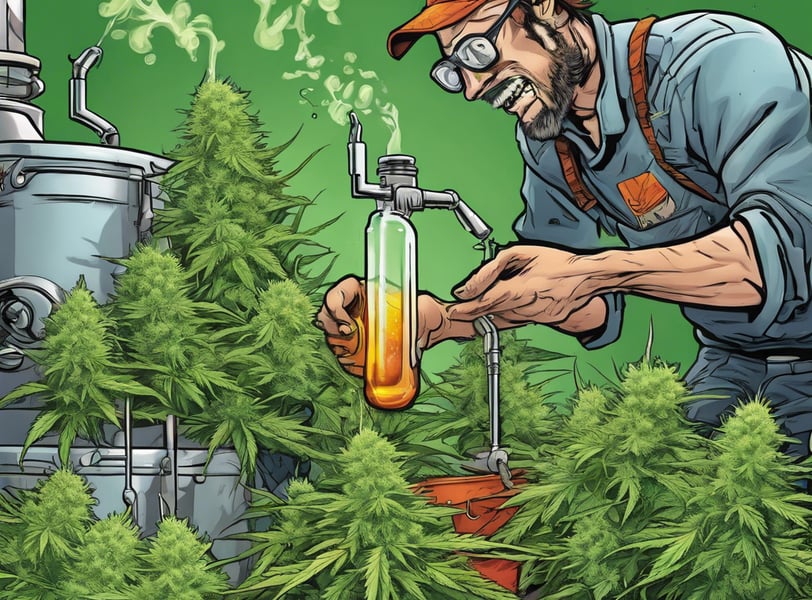Optimizing Hydrocarbon Extraction Efficiency: Temperature, Pressure, and Terroir
This post explores the interplay between extraction parameters, such as temperature and pressure, and terroir factors, highlighting strategies for growers to fine-tune their processes to maximize efficiency and product quality.
5/28/20243 min read


Unveiling Terroir's Influence: Elevating Cannabis Cultivation and Extraction
Welcome to a comprehensive exploration of terroir's profound impact on cannabis cultivation and extraction. In this immersive journey, we delve deep into the intricate interplay between environmental factors, extraction techniques, and the resulting terpene and cannabinoid profiles. From soil to solvent, join us as we uncover the secrets of terroir-driven cannabis production.
Terroir, a term originally rooted in viticulture, encompasses the unique combination of environmental factors that influence plant growth and development in a specific region. While traditionally associated with wine, the concept of terroir has found new relevance in cannabis cultivation. Soil composition, climate conditions, topography, and local ecosystems all contribute to the terroir of a cannabis cultivation site, shaping the plant's chemical composition and overall characteristics.
The soil is the literal and metaphorical foundation of terroir-driven cannabis cultivation. Different soil types, such as sandy, loamy, or clayey soils, offer varying levels of drainage, aeration, and nutrient availability. These factors profoundly impact plant health and growth, influencing the synthesis of cannabinoids and terpenes. For example, well-draining sandy soils may lead to more potent cannabis flowers, while nutrient-rich loamy soils can support a diverse terpene profile.
Soil health is further influenced by factors such as pH levels, organic matter content, and microbial activity. pH levels affect nutrient availability, with optimal ranges varying depending on the specific needs of cannabis plants. Organic matter, including compost and decomposed plant material, provides essential nutrients and supports microbial activity, which plays a crucial role in nutrient cycling and the release of bioavailable nutrients.
Climate conditions exert a profound influence on cannabis cultivation, dictating factors such as temperature, humidity, sunlight exposure, and precipitation. These variables directly impact the physiological processes of cannabis plants, influencing the synthesis of cannabinoids, terpenes, and other bioactive compounds.
Regions with consistent temperatures and ample sunlight often produce cannabis plants with higher cannabinoid concentrations and more pronounced terpene profiles. Conversely, extreme temperatures and fluctuations in humidity can stress plants, leading to lower yields and compromised quality. Understanding the unique climate dynamics of a cultivation site is essential for optimizing growing conditions and maximizing the expression of terroir.
The topography of a cultivation site, including elevation, slope orientation, and microclimates, further contributes to terroir complexity. Higher elevations may offer cooler temperatures and increased UV exposure, influencing the production of secondary metabolites such as cannabinoids and terpenes. Slope orientation affects sunlight exposure and water runoff, creating microclimates that can impact plant health and chemical composition.
Microclimates within a cultivation site can lead to variability in plant characteristics, even within a single field. Understanding and leveraging these topographical nuances allows growers to tailor cultivation practices to optimize plant health and maximize terroir expression.
Integrating the principles of terroir into cultivation practices is essential for maximizing cannabis quality and consistency. Selecting cannabis varieties suited to the specific terroir of a cultivation site ensures optimal adaptation to local environmental conditions. Strategic agricultural practices, such as soil amendments, irrigation management, and pest control, further enhance plant health and vitality.
Soil testing and analysis play a crucial role in understanding soil composition and nutrient availability, allowing growers to make informed decisions about fertilizer applications and soil amendments. Monitoring environmental variables such as temperature, humidity, and sunlight exposure provides valuable insights into plant health and growth, guiding adjustments to cultivation practices as needed.
Terroir-driven cultivation sets the stage for superior extraction outcomes, with each plant expressing the unique characteristics of its growing environment. Advanced extraction techniques, such as hydrocarbon extraction and supercritical CO2 extraction, preserve the integrity of cannabinoids and terpenes, capturing the essence of terroir in every extract.
Fine-tuning extraction parameters, such as temperature, pressure, and solvent selection, allows producers to optimize extraction efficiency and product quality. By harnessing the power of terroir and integrating it into extraction processes, producers can elevate cannabis products to new heights of potency, purity, and complexity.
In conclusion, terroir stands as a cornerstone of cannabis cultivation and extraction, shaping the flavor, aroma, and potency of cannabis products. By understanding and leveraging the unique environmental factors that define terroir, producers can unlock the full potential of cannabis plants, yielding extracts that reflect the essence of their growing environment. From soil to solvent, the journey of terroir-driven cannabis production is a testament to nature's complexity and the artistry of cultivation and extraction mastery.
Contacts
bart@smokyb420.com
(+27) 084-717-2943
